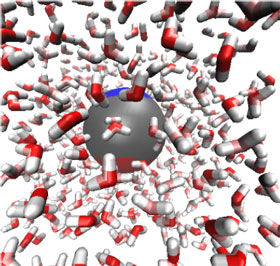A team of Swiss researchers used THz spectroscopy to measure the surprisingly slow response of solvating water after changing the charge distribution of a dissolved dye molecule.
From the Journal: The Journal of Chemical Physics
 WASHINGTON, D.C., June 27, 2018 — Liquid water sustains life on earth, but its physical properties remain mysterious among scientific researchers. Recently, a team of Swiss researchers used existing THz spectroscopy techniques to measure liquid water’s hydrogen bonding. Future efforts with this technique could one day help explain water’s peculiar properties. The team reports their findings in The Journal of Chemical Physics, from AIP Publishing.
WASHINGTON, D.C., June 27, 2018 — Liquid water sustains life on earth, but its physical properties remain mysterious among scientific researchers. Recently, a team of Swiss researchers used existing THz spectroscopy techniques to measure liquid water’s hydrogen bonding. Future efforts with this technique could one day help explain water’s peculiar properties. The team reports their findings in The Journal of Chemical Physics, from AIP Publishing.
“What makes this paper special is the aspect of THz spectroscopy of a liquid. In the THz range, we make spectroscopy explicitly of the intermolecular degrees of freedom of the system in the study, to contrast it to intramolecular degrees of freedom,” said Peter Hamm, an author on the paper. “With THz spectroscopy, we can very directly look at the hydrogen bonding between various water molecules.”
Researchers use spectroscopy to measure the interaction of matter with light and infer something’s physical composition. In this experiment, the researchers excited a dye molecule dissolved in water with an ultrashort visible laser pulse, changing its charge distribution. Then, a THz pulse measured the response of the surrounding water molecules as a function of the time after that excitation process.
THz spectroscopy, which is relatively low frequency, enables researchers to examine the forces that exist between water molecules. Observing these intermolecular forces could help researchers understand water’s anomalies, because hydrogen bonding in liquid water molecules make up many of water’s unexpected properties, like its unusual density maximum at 4 degrees Celsius.
“The response we found in the THz frequency range was surprisingly slow. Water is typically considered to be a very fast solvent with a response in the subpicosecond range, but we found a timescale around 10 picoseconds in the THz,” Hamm said. They attributed the slow timescale to the collective nature of the water response that was probed using THz spectroscopy.
Hamm clarified that researchers have been using THz spectroscopy for more than 20 years and cautioned optimism about the results. “The outcome often has been a bit disappointing because the THz spectra of liquids like water are extremely broad and blurred, and it’s very hard to extract information out of that,” he said. Time-resolved techniques, like in this study, might overcome that limitation.
Next, the researchers plan to use their method to look at water’s structure and dynamics when it’s still liquid, but below the freezing point. Hamm explained, “The special properties of water become significantly more pronounced if one goes to temperatures below the freezing point.”
###
For More Information:
Julia Majors
media@aip.org
301-209-3090
@AIPPhysicsNews
Article Title
Aqueous solvation from the water perspective
Authors
Saima Ahmed, Andrea Pasti, Ricardo J. Fernandez-Teran, Gustavo Ciardi, Andrey Shalit and Peter Hamm
Author Affiliations
University of Zurich
